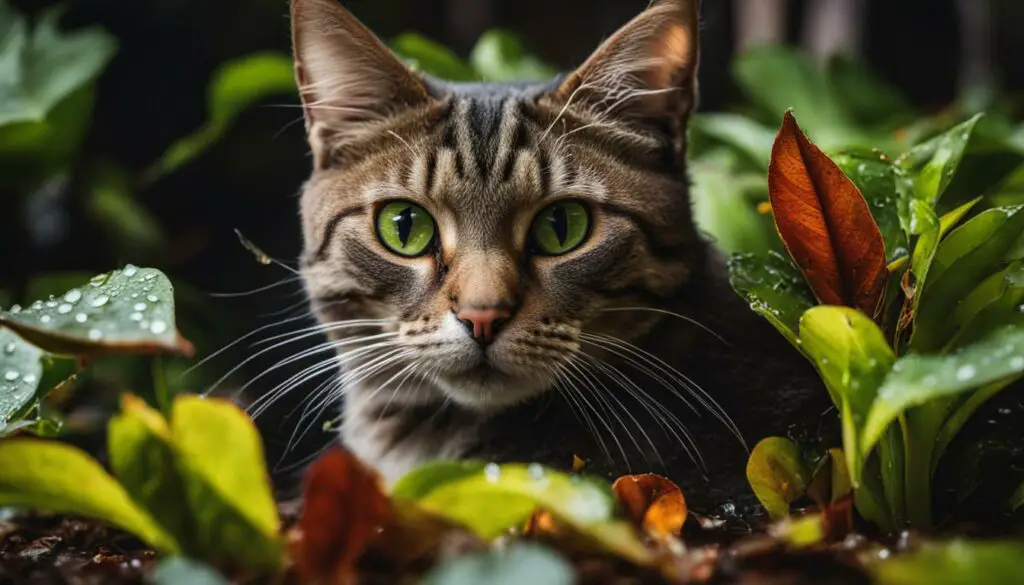If you find yourself in a situation where your cat has ingested a croton plant, it’s essential to take immediate action to ensure your feline’s safety. The croton plant (Codiaeum variegatum) is known to be toxic to cats, causing oral and gastrointestinal irritation. In this article, I will guide you through the symptoms to look out for, the immediate steps to take, and how to prevent such incidents in the future.
Key Takeaways:
- Common signs of croton ingestion in cats include vomiting, skin irritation, excessive drooling, diarrhea, and digestion problems.
- If your cat ingests a croton plant, contact a veterinarian or the Pet Poison Helpline for professional guidance.
- Do not induce vomiting in your cat unless instructed by a professional.
- Regularly check your cat’s litter for any changes in their stool and observe their behavior for signs of pain or discomfort.
- Prevent future incidents by keeping croton plants out of your cat’s reach and opting for cat-friendly indoor plants.
Symptoms of Croton Ingestion in Cats
When a cat ingests a croton plant, it can experience various symptoms. These include vomiting, skin irritation (especially if the cat has come into contact with the sap), excessive drooling, diarrhea, and digestion problems. The severity of these symptoms will depend on the amount of croton ingested. It is important to observe your cat for these signs and monitor their behavior for any changes that may indicate discomfort or pain.
Some cats may show immediate symptoms after ingesting a croton plant, while others may exhibit delayed symptoms. It is essential to pay close attention to your cat’s health and seek veterinary care if you suspect croton ingestion.
If you notice any of these symptoms or any other unusual behavior in your cat after they have ingested a croton plant, it is crucial to contact your veterinarian immediately. They will be able to provide further guidance and recommend appropriate treatment to ensure your cat’s well-being.
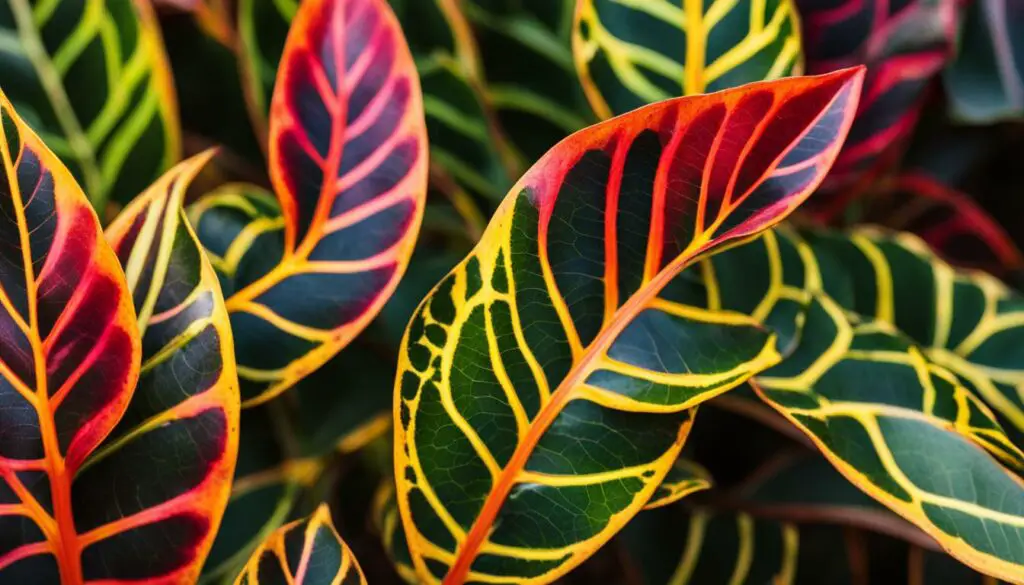
Symptoms of Croton Ingestion in Cats:
- Vomiting
- Skin irritation
- Excessive drooling
- Diarrhea
- Digestion problems
If your cat exhibits any of these symptoms after ingesting a croton plant, it is important to seek professional help to assess the toxicity level and provide appropriate treatment. Remember, early intervention can greatly improve your cat’s chances of recovering from croton ingestion.
| Symptom | Description |
|---|---|
| Vomiting | Expulsion of stomach contents through the mouth |
| Skin irritation | Redness, itching, or swelling of the skin, especially if the cat has come into contact with the sap of the croton plant |
| Excessive drooling | Increased production of saliva, often accompanied by dripping or foaming from the mouth |
| Diarrhea | Loose or watery stools |
| Digestion problems | Difficulty in digesting food, resulting in discomfort or changes in appetite |
Immediate Steps to Take If Your Cat Ingests a Croton Plant
If you suspect that your cat has ingested a croton plant, it is crucial to take immediate action to ensure their safety. Here are the steps you should follow:
- Contact a veterinarian or the Pet Poison Helpline: The first and most important step is to seek professional guidance. Contact your veterinarian or the Pet Poison Helpline to assess the level of toxicity and receive appropriate advice on what to do next.
- Observe your cat’s litter: Regularly check your cat’s litter for any changes in color, texture, or shape of their stool. This can provide important insights into your cat’s digestive health and help the veterinarian assess the impact of the croton ingestion.
- Monitor behavioral changes: Pay close attention to your cat’s behavior for any signs of pain or discomfort. Look out for hiding, nervousness, refusal of food, increased meowing, or aggression. These behavioral changes can indicate that your cat is experiencing discomfort and may require medical attention.
Remember, it is important not to induce vomiting in your cat unless instructed to do so by a professional. Promptly contacting a veterinarian or the Pet Poison Helpline is crucial for assessing the toxicity level and providing the best possible care for your cat.
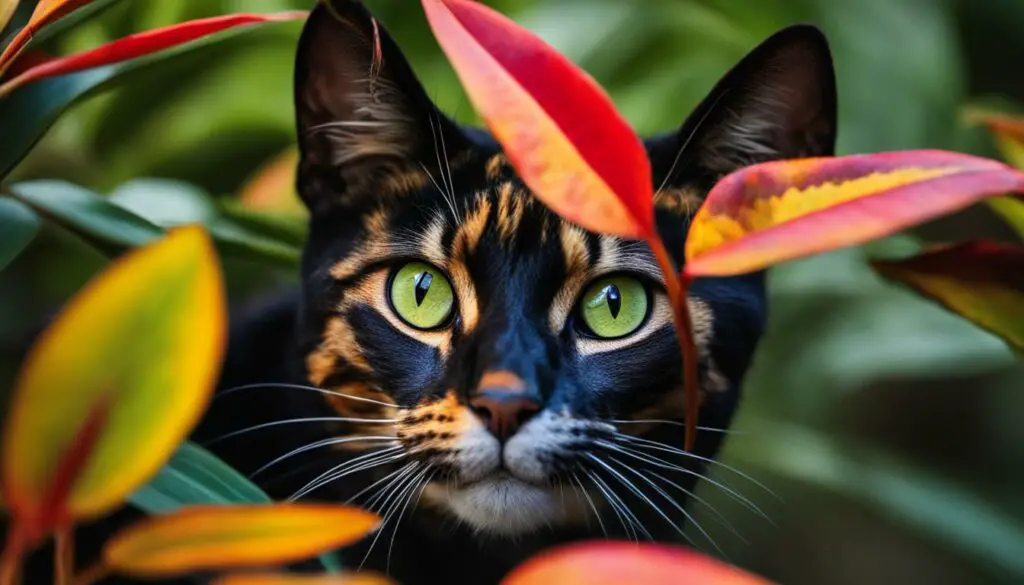
How to Keep Your Cat Safe from Croton Plants
When it comes to the safety of our feline companions, it’s essential to take preventive measures to ensure their well-being. If you have a croton plant in your home, it’s important to keep it out of reach from your curious cat. Although the bitter taste of croton plants may discourage cats from consuming them, it’s better to be safe than sorry. Here are some tips on how to keep your cat safe from croton plants:
- Place your croton plant in an area that is inaccessible to your cat, such as on a high shelf or inside a closed room.
- Consider using a plant stand or hanging baskets to keep the croton plant out of your cat’s reach.
- If you notice your cat showing interest in the croton plant, distract them with a cat-friendly toy or treat to redirect their attention.
Additionally, you may want to consider incorporating cat-friendly indoor plants into your home. These plants not only provide a safe alternative for your curious feline but also add a touch of greenery to your living space. Some cat-friendly indoor plants include Haworthia species, ferns, succulents, spider plants, and African violets. By choosing these non-toxic plants, you can create a cat-safe environment while still enjoying the benefits of indoor plants.
Why Cat-Friendly Indoor Plants are a Good Choice
Choosing cat-friendly indoor plants is a great way to ensure the safety of your feline companion. These plants are non-toxic and pose no harm to your cat if ingested. In addition to being safe, these plants offer various benefits:
- Improved air quality: Indoor plants act as natural air purifiers, removing toxins from the air and creating a healthier environment for both you and your cat.
- Stress reduction: The presence of indoor plants has been shown to reduce stress and anxiety in both humans and animals, promoting a calm and peaceful atmosphere.
- Visual appeal: Cat-friendly indoor plants come in various shapes, sizes, and colors, allowing you to create a visually appealing indoor garden that enhances your home decor.
By choosing cat-friendly indoor plants, you can provide a safe and enriching environment for your cat, ensuring their well-being and happiness.
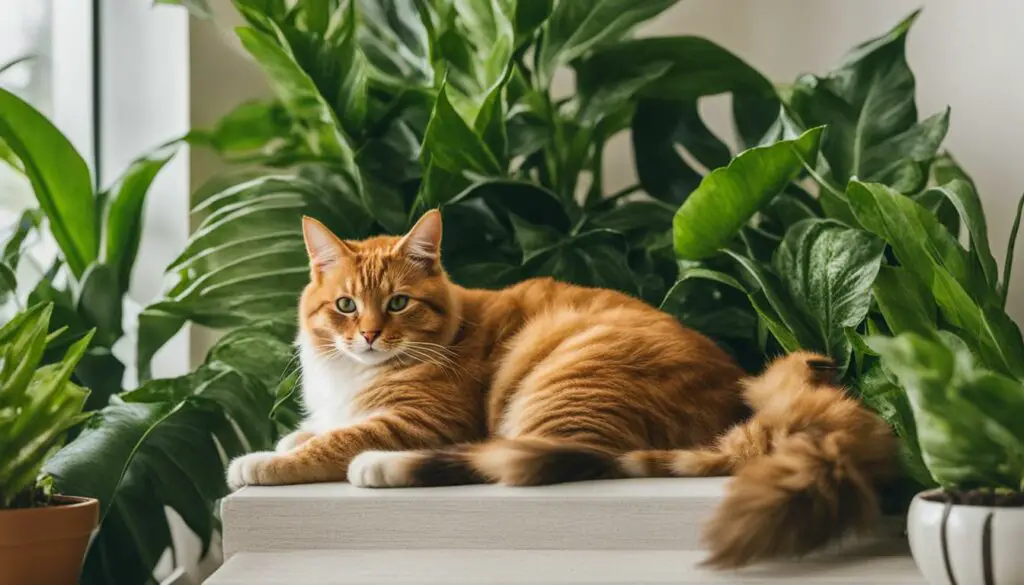
| Plant | Description |
|---|---|
| Haworthia species | Succulent plants with long, pointed leaves that require minimal care. |
| Ferns | Classic and adaptable plants that come in various styles and can be easily incorporated into your home decor. |
| Succulents | Colorful and easy-to-care-for plants that are visually appealing and safe for feline companions. |
| Spider plants | Popular plants that are harmless to cats and can be hung or placed on high surfaces to keep them out of reach. |
| African violets | Plants with beautiful domed leaves and colorful flowers that add a touch of brightness to any space while being safe for cats. |
Top 5 Cat-Friendly Indoor Plants
If you’re a cat owner looking to add some greenery to your home without compromising your feline friend’s safety, consider these top 5 cat-friendly indoor plants. Not only are these plants non-toxic to cats, but they also add a touch of natural beauty to your living space.
- Haworthia species – These charming succulent plants feature long, pointed leaves and require minimal care. They come in various shapes and colors, making them a stylish addition to any room.
- Ferns – Classic and adaptable, ferns come in a wide variety of styles and can be easily incorporated into your home decor. They thrive in low-light conditions and provide a lush, green aesthetic.
- Succulents – Colorful and easy to care for, succulents are visually appealing and safe for feline companions. Their unique shapes and textures add interest to any indoor space.
- Spider plants – Popular and harmless to cats, spider plants can be hung or placed on high surfaces to keep them out of reach. Their cascading leaves add a touch of elegance and drama to any corner.
- African violets – With their beautiful domed leaves and colorful flowers, African violets add a touch of brightness to any space while being safe for cats. They thrive in bright, indirect light and are relatively low-maintenance.
These cat-friendly indoor plants provide a safe and appealing alternative to potentially toxic options. Remember to always ensure that plants are securely placed and out of your cat’s reach to prevent any accidental nibbling. By incorporating these non-toxic plants into your home, you can create an inviting and pet-friendly environment for both you and your beloved feline companion.
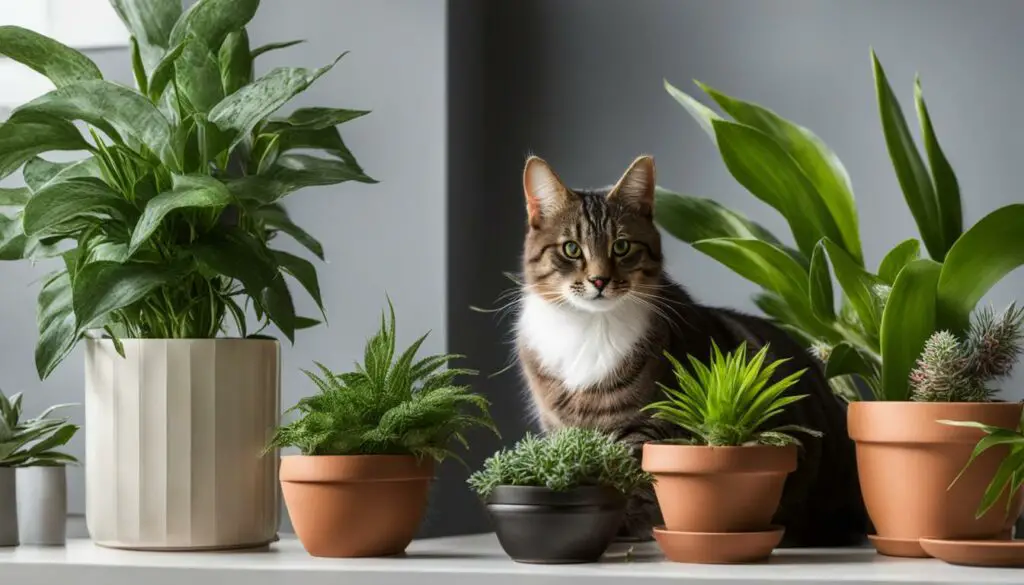
Summary:
When it comes to indoor plants, it’s essential to prioritize your cat’s safety. By choosing cat-friendly options like Haworthia species, ferns, succulents, spider plants, and African violets, you can introduce greenery into your home without worrying about potential toxicity. These plants not only add a touch of beauty to your living space but also provide a safe environment for your furry friend to explore. Remember to keep plants out of reach and enjoy the benefits of a harmonious coexistence between plants and pets.
Croton Plant Toxicity to Cats
It is crucial for cat owners to be aware of the toxicity associated with the croton plant (Codiaeum variegatum). All parts of the plant are toxic to cats, containing compounds called phorbol esters. These substances stimulate Protein Kinase C, a group of enzymes that play a role in various cellular processes. When a cat ingests the croton plant, these phorbol esters can have harmful effects on their health.
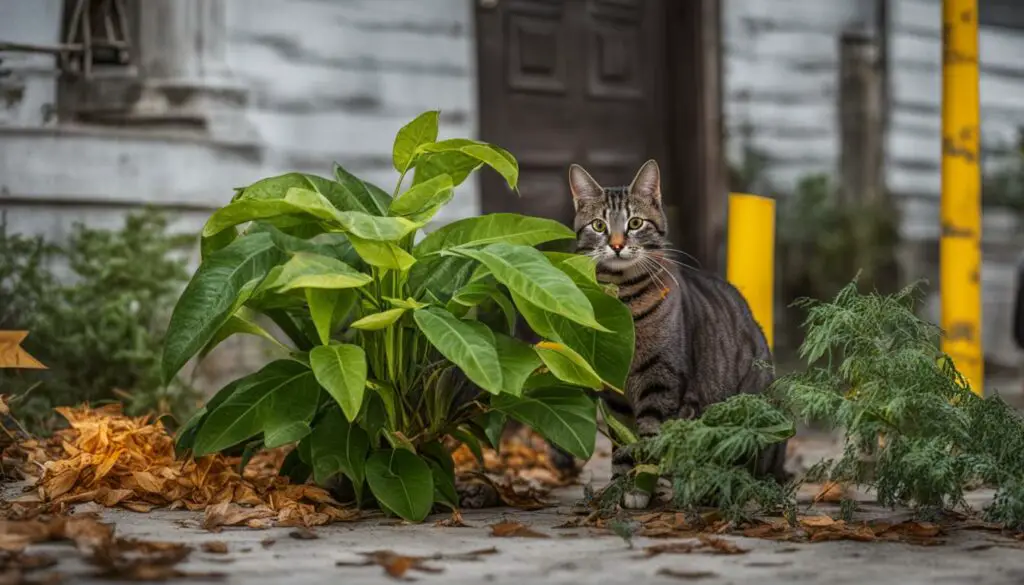
The severity of toxicity can vary depending on the amount ingested and the overall health of the cat. If you suspect that your cat has ingested a croton plant, contacting a veterinarian is essential. They can assess the level of toxicity and provide appropriate treatment to ensure your cat’s well-being.
When speaking to your veterinarian, it is important to inform them of the specific part of the croton plant that your cat consumed. Whether it is a leaf, root, or another part, this information can help the veterinarian determine the best course of action. Immediate medical attention is crucial in cases of croton plant ingestion to prevent further complications.
Common Signs of Croton Plant Toxicity in Cats:
- Vomiting
- Diarrhea
- Excessive drooling
- Skin irritation (especially if contact with the sap)
- Digestion problems
Remember, if you suspect your cat has ingested a croton plant, always seek professional advice from a veterinarian. They can provide specific guidance tailored to your cat’s situation. By being proactive and knowledgeable about potential plant toxicities, you can keep your feline companion safe and healthy.
Immediate Response to Cat Ingestion of Croton Plant
When you discover that your cat has ingested a croton plant, it is crucial to act quickly and effectively. Here are the immediate steps you should take to ensure the safety and well-being of your feline companion:
Gentle Examination
Begin by calmly examining your cat. Gently open their mouth and check for any plant pieces. Carefully remove any remnants from their mouth to prevent further ingestion or irritation.
Brush Off Plant Residue
Next, use a soft brush or cloth to gently brush off any remaining plant pieces from your cat’s body. Pay special attention to their fur, paws, and any areas where the plant sap may have come into contact with their skin.
Secure Area
Place your cat in a secure and comfortable area, such as a quiet room or enclosure. This will help prevent them from running off or having access to other potentially harmful objects while you seek veterinary assistance.
Contact Your Veterinarian
Immediately reach out to your veterinarian or the nearest 24/7 animal hospital for guidance and instructions. They will be able to provide professional advice tailored to your cat’s specific situation and determine the appropriate course of action.
Remember, time is of the essence when it comes to your cat’s health. By following these steps and seeking veterinary help promptly, you can help ensure the best possible outcome for your beloved feline.
Recognizing Symptoms of Poisonous Plant Ingestion in Cats
If your cat has ingested a poisonous plant, it is crucial to be able to recognize the symptoms and take appropriate action. Cats may exhibit various signs of plant toxicity, including diarrhea, vomiting, drooling, skin irritation, lethargy, and changes in heart rate or breathing. Monitoring your cat’s behavior and physical condition is essential to ensure their well-being.
Cat symptoms of plant ingestion can range from mild to severe, depending on the type and amount of the plant consumed. Diarrhea and vomiting are common signs that your cat’s digestive system is affected. Excessive drooling can indicate oral irritation. Skin irritation may occur if the cat comes into contact with certain plants or their sap. Lethargy and changes in heart rate or breathing can be indicators of a more serious reaction.
It is important to note that these symptoms may not appear immediately after ingestion. In some cases, the signs may develop gradually over time. If your cat shows any of these symptoms and you suspect plant ingestion, it is crucial to seek veterinary assistance as soon as possible. A veterinarian will be able to provide the appropriate diagnosis and treatment to ensure your cat’s health and well-being.
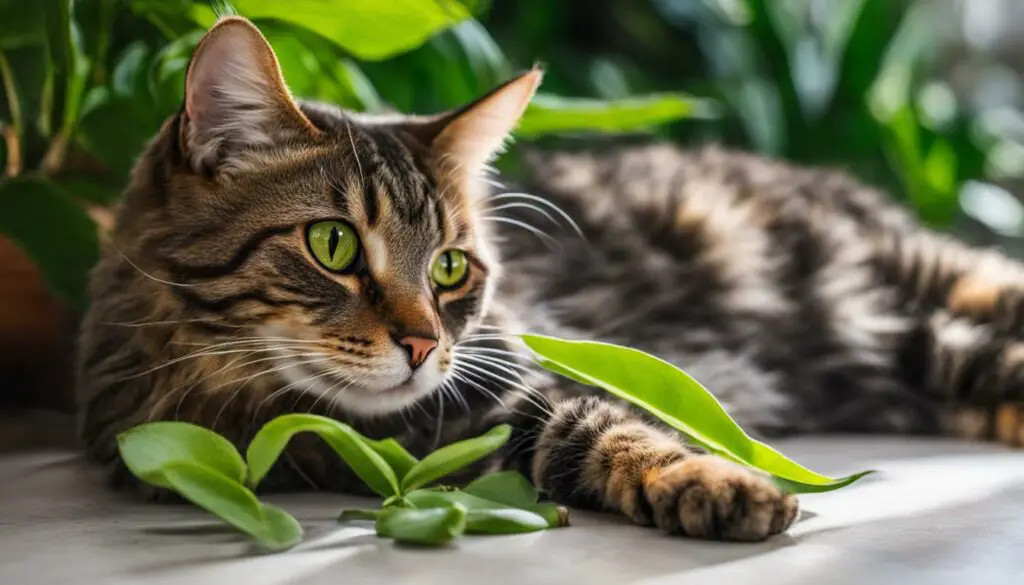
| Symptoms of Poisonous Plant Ingestion in Cats | Immediate Actions to Take |
|---|---|
| Diarrhea |
|
| Vomiting |
|
| Drooling |
|
| Skin Irritation |
|
| Lethargy |
|
| Changes in heart rate or breathing |
|
Non-Toxic Houseplants for Cat Owners
As a cat owner, it’s essential to create a safe environment for your feline friends. One way to do this is by choosing non-toxic houseplants. These plants not only add beauty to your home but also give you peace of mind knowing that they won’t harm your beloved pets. Here are two excellent options:
Spider plant (Chlorophytum comosum)
The spider plant is a popular choice for cat owners because it is non-toxic to cats. Its long, arching leaves and delicate white flowers bring a touch of elegance to any space. Spider plants are also known for their air-purifying qualities, making them a great addition to your indoor garden. Just make sure to place them in areas where your curious feline can’t reach them, as they may still be tempted to play with the leaves.
Duffy fern (Nephrolepis cordifolia ‘duffii’)
If you’re looking for a low-maintenance plant that is safe for your cat, the Duffy fern is an excellent choice. With its lush, feathery fronds, this fern adds a touch of natural beauty to any room. It thrives in low-light conditions and requires minimal care, making it perfect for busy cat owners. The Duffy fern is a safe and stylish option that will bring a refreshing green appeal to your home.
When selecting houseplants for your cat-friendly home, always double-check their toxicity level. It’s important to remember that even non-toxic plants can cause mild gastrointestinal upset if ingested in large quantities. By choosing non-toxic houseplants like the spider plant and Duffy fern, you can create a beautiful and safe environment for both you and your feline companions.
FAQ
What should I do if my cat ate a croton plant?
If your cat has ingested a croton plant, it is important to take immediate steps to ensure their safety. Contact your veterinarian or the Pet Poison Helpline for guidance and instructions.
What are the symptoms of croton ingestion in cats?
Symptoms of croton ingestion in cats may include vomiting, skin irritation, excessive drooling, diarrhea, and digestion problems.
What immediate steps should I take if my cat ingests a croton plant?
If you suspect your cat ingested a croton plant, contact a veterinarian or the Pet Poison Helpline for professional guidance. Do not induce vomiting unless instructed by a professional. Observe your cat’s behavior and monitor their litter for any changes in stool appearance.
How can I keep my cat safe from croton plants?
To keep your cat safe from croton plants, ensure they are out of reach of your feline companion. Alternatively, consider cat-friendly indoor plants that are safe for cats.
What are the top 5 cat-friendly indoor plants?
Cat-friendly indoor plants include Haworthia species, ferns, succulents, spider plants, and African violets. These plants provide greenery to your home without posing any harm to your cat.
How toxic is the croton plant to cats?
The croton plant is toxic to cats due to the presence of phorbol esters, which can have harmful effects on a cat’s health. All parts of the plant are toxic.
What should be my immediate response if my cat ingests a croton plant?
Start by calmly examining your cat and gently removing any plant pieces from their mouth. Brush off any remaining plant pieces from their body and place your cat in a secure area. Contact your veterinarian or the nearest 24/7 animal hospital for guidance and instructions.
What are the symptoms of poisonous plant ingestion in cats?
Symptoms of poisonous plant ingestion in cats may include diarrhea, vomiting, excessive drooling, skin irritation, lethargy, and changes in heart rate or breathing.
What are some non-toxic houseplants for cat owners?
Spider plants and Duffy ferns are two examples of non-toxic houseplants that are safe for cat owners. These plants can enhance your home decor without posing a risk to your feline companions.

